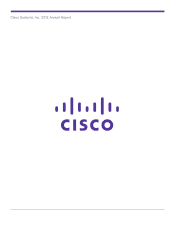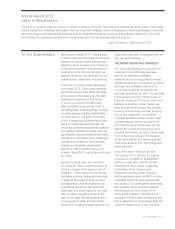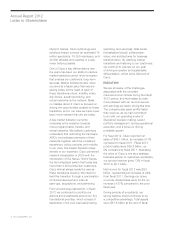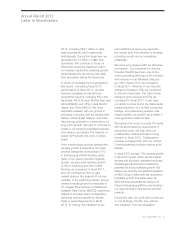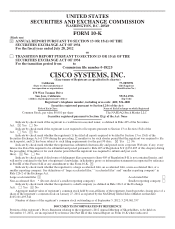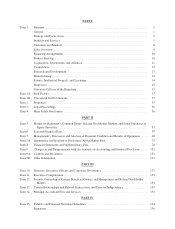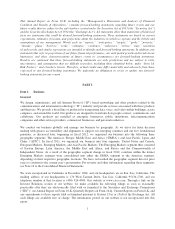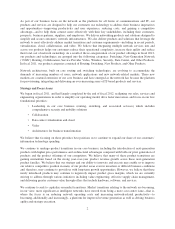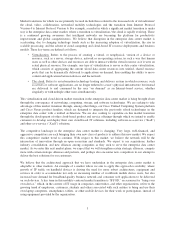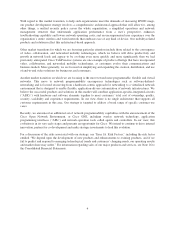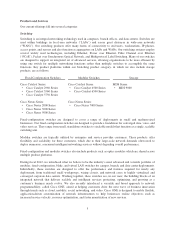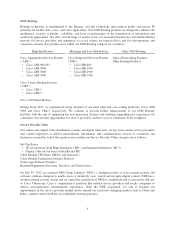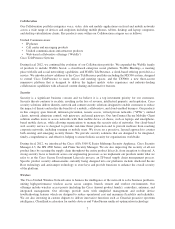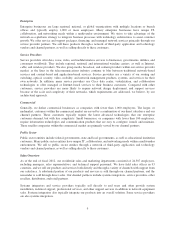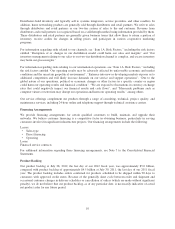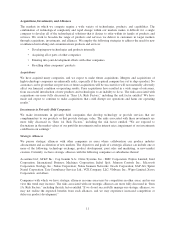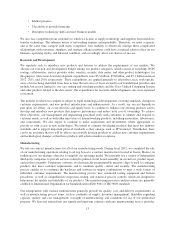Cisco 2012 Annual Report Download - page 11
Download and view the complete annual report
Please find page 11 of the 2012 Cisco annual report below. You can navigate through the pages in the report by either clicking on the pages listed below, or by using the keyword search tool below to find specific information within the annual report.
Market transitions for which we are primarily focused include those related to the increased role of virtualization/
the cloud, video, collaboration, networked mobility technologies and the transition from Internet Protocol
Version 4 to Internet Protocol Version 6. For example, a market in which a significant market transition is under
way is the enterprise data center market, where a transition to virtualization / the cloud is rapidly evolving. There
is a continued growing awareness that intelligent networks are becoming the platform for productivity
improvement and global competitiveness. We believe that disruption in the enterprise data center market is
accelerating, due to changing technology trends such as the increasing adoption of virtualization, the rise in
scalable processing, and the advent of cloud computing and cloud-based IT resource deployments and business
models. These key terms are defined as follows:
• Virtualization: Refers to the process of creating a virtual, or nonphysical, version of a device or
resource, such as a server, storage device, network or an operating system, in such a way that human
users as well as other devices and resources are able to interact with the virtual resource as if it were an
actual physical resource. For example, one type of virtualization is server or data center virtualization,
which consists of aggregating the current siloed data center resources into unified, shared resource
pools that can be dynamically delivered to applications on demand, thus enabling the ability to move
content and applications between devices and the network.
• The cloud: Refers to an information technology hosting and delivery system in which resources, such
as servers or software applications, are no longer tethered to a user’s physical infrastructure but instead
are delivered to and consumed by the user “on demand” as an Internet-based service, whether
singularly or with multiple other users simultaneously.
This virtualization and cloud-driven market transition in the enterprise data center market is being brought about
through the convergence of networking, computing, storage, and software technologies. We are seeking to take
advantage of this market transition through, among other things, our Cisco Unified Computing System platform
and Cisco Nexus product families, which are designed to integrate the previously siloed technologies in the
enterprise data center with a unified architecture. We are also seeking to capitalize on this market transition
through the development of other cloud-based product and service offerings through which we intend to enable
customers to develop and deploy their own cloud-based IT solutions, including software-as-a-service (“SaaS”)
and other-as-a-service (“XaaS”) solutions.
The competitive landscape in the enterprise data center market is changing. Very large, well-financed, and
aggressive competitors are each bringing their own new class of products to address this new market. We expect
this competitive market trend to continue. With respect to this market, we believe the network will be the
intersection of innovation through an open ecosystem and standards. We expect to see acquisitions, further
industry consolidation, and new alliances among companies as they seek to serve the enterprise data center
market. As we enter this next market phase, we expect that we will strengthen certain strategic alliances, compete
more with certain strategic alliances and partners, and perhaps also encounter new competitors in our attempt to
deliver the best solutions for our customers.
We believe that the architectural approach that we have undertaken in the enterprise data center market is
adaptable to other markets. An example of a market where we aim to apply this approach is mobility, where
growth of IP traffic on handheld devices is driving the need for more robust architectures, equipment and
services in order to accommodate not only an increasing number of worldwide mobile device users, but also
increased user demand for broadband-quality business network and consumer web applications to be delivered
on such devices. A key term in this mobility-centered market transition is “BYOD,” an acronym for “bring your
own device,” which, in the context of IT usage in companies, universities, and other organizations, refers to the
growing trend of employees, customers, students and others associated with such entities to bring and use their
own laptop computers, smartphones, tablets, or other mobile devices for their work or participation, instead of
using equipment provided by the organization.
3

